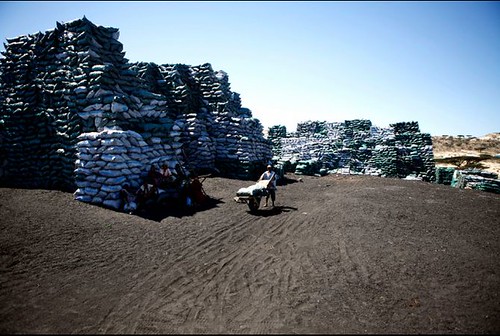
Charcoal exports at the port of Kismayo in southern Somalia. The area was recently occupied by the US-backed Kenyan Defense Forces in an effort to destroy the economic base for the Al-Shabab resistance movement., a photo by Pan-African News Wire File Photos on Flickr.
November 19, 2013
UN Charcoal Ban Crucial to Somalia Survival
by VOA News
Al-Shabab militants, who control portions of southern Somalia, have long relied on charcoal exports to Gulf Arab states to fund their operations and pay their recruits. Now, following the al-Shabab attack on Nairobi’s Westgate shopping mall in September that killed at least 67 people, there is renewed urgency at shutting down the charcoal pipeline. U.N. officials who are pushing the effort have so far had little success in curbing the trade but the recent seizure of a ship carrying charcoal to Dubai may change that.
Convincing Middle Eastern ports to prevent Somalia charcoal imports has been difficult. On any given day, as many as 22 dhows and two steel-hulled ships dock at Kismayo, Somalia’s major southern port on the Indian Ocean, to deliver sugar and concrete while laborers load bags of charcoal bound for thriving Middle Eastern markets where prices are three and four times the local Somali market.
In an important test of U.N. efforts to tighten sanctions among Middle Eastern governments, the United Arab Emirates seized the boat, crew and cargo of M/V Energy 3, which docked at Port Rashid with 140,000 sacks of charcoal in August. U.N. officials and others working to curb the trade say more port seizures such as this could discourage investors and limit the trade.
Despite the continued trafficking, the U.N. Special Representative to Somalia, Nicholas Kay, told VOA that in his talks with officials from the United Arab Emirates he believes “they have an earnest commitment.” Kay also said President Hassan Sheikh Mohamud of Somalia is “resolute in ending charcoal exports.”
“If they stop profits, the trade will die out,” Kay said.
“UAE needs to make the sanctions a higher priority,” said Ken Menkhaus, a Somali scholar at Davidson College in Davidson, North Carolina. He said the terrorist attack by al-Shabab terrorists on the Westgate shopping mall in Nairobi “should give them an incentive.”
Trade continues despite setbacks to al-Shabab
Al-Shabab forces have suffered major losses recently such as control of the southern port of Kismayo where much of Somalia’s charcoal was being shipped to Middle Eastern markets. However, according to a recent 486-page Monitoring Group on Somalia and Eritrea report to the U.N. Security Council, al-Shabab charcoal revenues of $25 million in 2011 have increased due to increasing exports to Saudi Arabia and the United Arab Emirates, the two largest of many Middle Eastern consumers of the illicit charcoal.
Despite losing Kismayo, al-Shabab continues to profit from charcoal exports in two ways.
They continue to control rural central and southern portions of Somalia and at will set up checkpoints to tax truckloads of charcoal bound for Kismayo. The U.N. report estimates that one checkpoint south of the port netted the terrorists $675,000 and $1.5 million in taxes in a recent month. They also remain in control of Barawe, a smaller port north of Kismayo which is filled with dhows and offshore vessels loading charcoal for the Middle East.
In a country with little electrical power, charcoal is the predominant domestic cooking fuel and is now managed by a network of more than 30 local brokers and a variety of armed groups who vie for regional control of production.
The U.N. Monitoring Group cited many armed groups identified as “spoilers” – including members of parliament, clan-based paramilitaries, Mogadishu warlords and the international peacekeepers of the Kenya Defense Forces (KDF) – who benefit from the export of Somalia’s charcoal to Saudi Arabia, the United Arab Republics and other Gulf states in nationwide sales now reaching approximately $384 million.
“The acacia is highly valued and has made fortunes for warlords, Shabab and the KDF in Kismayo,” said Menkhaus. “Everyone has got an interest in charcoal,” said Menkhaus. “It’s just business.”
The overseas market continues to thrive due to the popularity of meats grilled in Middle Eastern homes and restaurants using charcoal with the aroma and long-burning qualities of the dense wood of acacia forests growing between the Shabelle and Juba rivers in southern Somalia.
The harvest of Somalia’s remaining acacia forests is performed by local Somalis – those who have not been driven from their lands by violence – who cut the trees and dig holes in the savannahs to burn the branches under intense heat and sell the products to regional brokers.
“They have no other livelihood,” said Menkhaus.
Environmental devastation adds to woes
Somalia’s once-vast acacia forests now cover only nine percent of the nation and the ambitious reforestation campaigns of the previous administrations of Siad Barre and Gen. Mohammad Farah Aided are history.
The harvest is denuding the savannah and making portions of southern Somalia unsuitable for human habitation by accelerating soil erosion, reducing the arability of the land, depriving cattle and goats of shade in the savannah’s intense heat, reducing foliage for grazing camels, and killing tree root systems once capable of retaining moisture in the soil.
“It’s a wasteland of stumps from a Lorax movie,” said Menkhaus, who recently walked through the reduced acacia forests. The return of Somalia’s acacias can only occur if this country’s civil war ends, and that’s not likely to happen soon.
http://www.voanews.com/content/un-charcoal-ban-crucial-to-somalia-survival/1793038.html
No comments:
Post a Comment